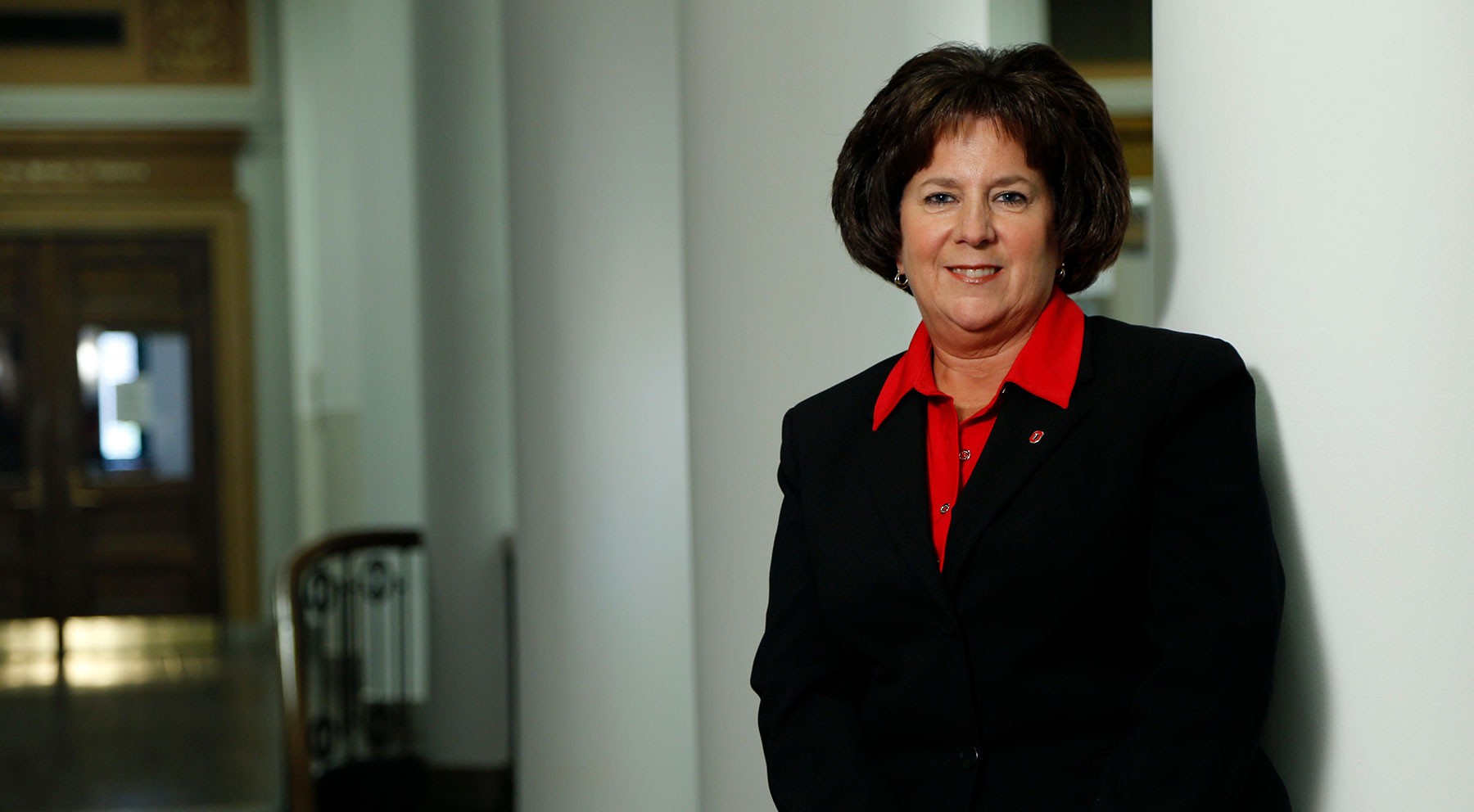Topping the HR agenda: talent, total rewards and excellent service
Senior VP Susan Basso fields staff questions at USAC eve

Add me on LinkedIn (opens in new window)
|
Emily Caldwell Ohio State News |
Though a major responsibility of her role at The Ohio State University involves overseeing a massive technology upgrade, Susan Basso has also applied her big-picture thinking to an HR strategic plan that keeps each individual employee’s work experience top of mind.
On May 10, Basso, senior vice president for talent, culture and human resources, outlined her team’s priorities during a public conversation hosted by the University Staff Advisory Committee. When USAC opened the floor for questions, Basso invited those in attendance to share their challenges. After 25 years of higher-education HR leadership, she understands the concerns are out there.
Her own approach with the audience was frank during the hour-long session. Basso acknowledged that change is hard, compensation is very personal and no one particularly enjoys the performance management process, herself included.
That said, she is a believer in creating a culture of accountability and respect, all in the name of enhancing the employee experience. Culture is one of five foundational themes outlined in the upcoming HR strategic plan along with diversity and inclusion, communication, change management, and compliance and risk management. These themes extend across the three strategic pillars that will shape HR efforts in coming years: HR excellence, talent management and total rewards.
“We can’t do anything if we don’t have a really strong people strategy,” Basso said, emphasizing her team’s focus on attracting and retaining top-tier talent and offering compensation that includes an exceptional and affordable benefits package.
Ensuring that Ohio State can retain high-quality employees and recruit competitively is an established priority across the university, Basso said.
“Everybody understands that our future is very dependent on the ability to attract and retain top-tier talent,” she said – especially when the talent pipeline is shrinking.
“I describe it as an arms race – we’re all competing for the same pretty small pool of people,” she said. “And when we have good people, we’re focused on what HR can do to enable your growth and development to prepare you to fill new roles as leaders retire or move on.”
That retention piece is important, Basso noted. It requires a comprehensive strategy to shape performance conversations to reflect employee aspirations and enables managers to create leadership opportunities for staff.
It’s no secret that compensation has a huge influence on the success of recruitment and retention. After hearing that several staff submitted questions regarding inconsistencies around pay, the merit process and job descriptions, Basso reminded the audience that a compensation and classification redesign is in progress, but is a significant undertaking given Ohio State’s decentralized structure.
“This is hard work to do. When we talk about people’s compensation and benefits, it’s extremely personal. We understand and want to be sensitive to that,” she said. “The primary motive to do this and do it right is related to talent strategy. It’s hard to have a line of sight to opportunity if some fundamental things are not in place.”
Basso also said that the public status of Ohio State’s employee compensation – now posted online by the university, which “from an institutional perspective is the right thing to do” – makes it easy to spot apparent disparities. She noted that there are many permissible gaps in pay that salary figures alone don’t explain: Differences in academic credentials, professional experience and time spent in a position, for example, mean “it’s not just as simple as you set a salary range and move everyone into it.”
Once the salary structure is established, the compensation team will be better equipped to conduct local and national market analyses on a regular basis – an important way to ensure Ohio State is offering fair and competitive salaries.
The upgrade of business-process technologies also looms large. Ohio State is in the midst of an Enterprise Project that will modernize and standardize how the university manages finance, HR, student services and information technology. Basso has completed four similar projects at other institutions, including at Penn State and its 24 regional campuses.
Basso said the next phase of communication about the project will focus on what the new technologies will mean for staff and faculty. It’s not uncommon for employees to dread the learning curve that goes with this kind of upgrade, she acknowledged. She encouraged staff to embrace change rather than fight it, and to focus on the benefits the project will bring to the institution and, most importantly, to students.
Addressing the anxiety that accompanies plans to reduce redundancy and create efficiencies, Basso said, “The big message here is people are not going to be losing jobs, but we’re going to be working differently.”
The HR strategic plan is still being finalized and is expected to be shared across the university in the next several weeks. Basso has invited leader-development expert Becky Halstead, a retired U.S. Army brigadier general and founder of the consulting company STEADFAST Leadership, to speak to HR staff at a May 16 town hall focused on planning for implementation of the strategic plan.
“Hopefully, when you read our strategic plan, you will see yourself in there somewhere,” Basso said. “We cannot be all things to everybody and we can’t work on everything. … What we have to think systematically about is the things that we need to work on that are going to lay a great foundation for the future.


